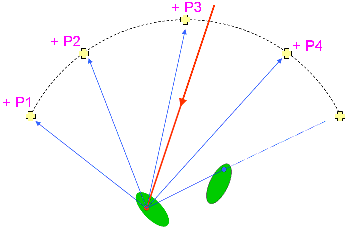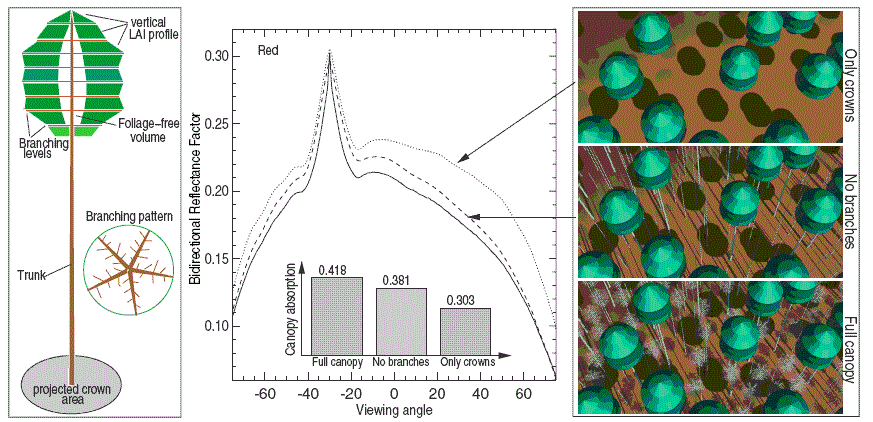
Phase: RAMI 3
The Rayspread model, which is an extension of the raytran model of Govaerts and Verstraete, (1998), samples all relevant radiative processes within a 3-D scene by following individual primary rays from their energy source, through all relevant interactions, until an absorption or exit event occurs. In addition, a variance reduction method known as "photon spreading" (Thompson and Goel, 1998) has been implemented to achieve significantly faster simulations of BRF fields.
This local estimator technique implies the "spreading" of secondary rays towards a series of detectors from every physical interaction point in the path of the primary rays.
Rayspread maintains backward compatibility with the model syntax of its predecessor, to allow for the computation of radiative quantities other than BRFs (i.e., transmission, absorption, albedo, etc.), and to use (if deemed appropriate) the Message Passing Interface (MPI) as a communicating layer within a distributed memory, parallel processor architecture.

Rayspread maintains backward compatibility with the model syntax of its predecessor, to allow for the computation of radiative quantities other than BRFs (i.e., transmission, absorption, albedo, etc.), and to use (if deemed appropriate) the Message Passing Interface (MPI) as a communicating layer within a distributed memory, parallel processor architecture.
In its current form, the Rayspread model assumes that 1) light propagation can be described entirely with geometrical optics, 2) incident monochromatic radiation can be simulated with a finite number of mutually non-interacting rays, and 3) whenever a ray-matter interaction occurs along the trajectory of a primary ray, the ray is scattered in one and only one direction under elastic scattering conditions. To set up an experiment with this model, the structural and optical properties of the medium of interest have to be defined prior to the computation of the ray trajectories.
A set of 12 geometric primitives (e.g., disc, cone, sphere, cylinder, ellipse), may be combined using Constructive Solid Geometry (CSG) techniques to produce objects of great complexity. Every object within the bounding volume of the scene (known as the world object) is characterized by its position with respect to the world cartesian coordinate system, its spatial extension and an interaction model that specifies the objects scattering properties if a ray intersects its outer envelope or is to be propagated within the spatially homogeneous media defined inside its (closed) interior. A light source is defined in terms of its location, extent, intensity and directionality. Multiple light sources may be combined to simulate complex illumination conditions. Last but not least, a series of virtual filters (and logical combinations thereof) can be applied to BRF measurements such that only certain scattering orders, or, object-specific physical interactions may contribute towards the radiance counter of a given detector.
